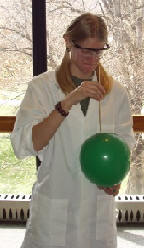Skewer a Balloon
Introduction
Think you can't stick a skewer all the way through a balloon without popping
it? Think again! This trick will amaze your friends!
Safety
- An adult must be present.
Supplies
- Balloons - better have a few on hand to practice!
- Bamboo Shish Kabob Skewers, or knitting needles
- Oil (mineral, baby, cooking...) - optional
Directions
- (Optional) soak the skewer or knitting needle in the oil for a few
minutes.
- Blow the balloon up, but not too full, the softer it is, the easier to
skewer it.
- Starting with the top of the balloon where the color is the darkest,
slowly start to spin the skewer as you gently press on the balloon.
- Keep spinning until the skewer goes into the balloon.
- Next, slowly push the skewer to the opposite side, where the balloon is
tied off, and as you contact the balloon, start to spin the skewer again,
applying gentle pressure as before.
- Did the balloon pop??? Practice makes perfect, gentle and spinning
is the key.
Observations
- What happens as you spin the skewer?
- Did the balloon pop? Why do you think that happened?
What's Happening?!?
Balloons are made of a thin sheet of a rubber called latex, a polymer
made of long chain-like molecules, or strands, that are all tangled together.
There are also bonds between the strands, call cross-links. This tangled,
cross-linked network of molecules can be stretched, but when you let go, it
returns to its original shape. Such a material is called an elastomer.
When a very sharp skewer is slowly pushed, with twisting, into the
balloon, the polymer chains are pushed aside, but remain bonded, so the balloon
does not break. (It helps, too, if the skewer is coated with an oil, such as
mineral oil or vegetable oil. It slides in more easily, and the oil helps seal
the hole.) When a balloon is blown up, the polymer strands are more tightly
stretched around the sides than they are at the tied end or the nipple end. It's
easier to push the skewer in at the ends, where the strands have more
"give." Around the side of the balloon, where the strands are
stretched more tightly, they are more likely to break. Once a tear begins,
it continues to enlarge, the air rushes out of the balloon, and it pops.
When you give the balloon a sharp poke with the skewer, the strands are
broken, and the balloon pops.
Have you noticed that helium balloons deflate (get soft) fairly quickly, and
that air filled balloons deflate more slowly? That's because there are small
spaces (on a molecular scale) between the polymer strands, and atoms or
molecules can effuse, or leak out, through these spaces. Helium atoms are
much smaller than the molecules making up air, so they effuse more rapidly, but
the nitrogen and oxygen molecules in air effuse more slowly.
still have questions? email
us!
|